Sociology > QUESTIONS & ANSWERS > CHCECE001 Develop cultural competence CHCDIV002 Promote Aboriginal and/or Torres Strait Islander cul (All)
CHCECE001 Develop cultural competence CHCDIV002 Promote Aboriginal and/or Torres Strait Islander cultural safety Theory Assessment Task
Document Content and Description Below
CHCECE001 Develop cultural competence CHCDIV002 Promote Aboriginal and/or Torres Strait Islander cultural safety Theory Assessment Task CHCECE001 Develop cultural competence CHCDIV002 P... romote Aboriginal and/or Torres Strait Islander cultural safety Theory Assessment Task Unit Purpose This unit co-assesses CHCECE001 and CHCDIV002. The assessment tasks within this unit provide you with the opportunity to demonstrate evidence of the knowledge and skills required to enable you to work with Aboriginal and Torres Strait Islander people, including identifying cultural safety issues in the workplace, modelling cultural safety in your own work practices and developing strategies to enhance cultural safety. The assessment tasks also provide you with the opportunity to demonstrate evidence of the required knowledge and skills to address duty of care requirements as well as work within an ethical framework, and apply relevant legislation, policies and procedures in responding to children and young people. Elements – CHCECE001 Develop cultural competence The following elements define the essential outcomes of this unit: Element 1 Reflect on own cultural identity and biases Element 2 Identify and develop cultural competency Element 3 Research Aboriginal and/or Torres Strait Islander communities Element 4 Support individual cultural identities Element 5 Create environments to support children’s cross-cultural understanding and relationships Element 6 Support the implementation of inclusive learning experiences Element 7 Support children in developing confidence and strength in personal and cultural identity Elements – CHCDIV002 Promote Aboriginal and/or Torres Strait Islander cultural safety The following elements define the essential outcomes of this unit: Element 1 Identify cultural safety issues in the workplace Element 2 Model cultural safety in own work Element 3 Develop strategies for improved cultural safety Element 4 Evaluate cultural safety strategies Assessment Requirements • 001: Cultural Competence • 002: Cultural Identity and Bias • 003: Aboriginal and/or Torres Strait Islander Cultural Identity • 004: Aboriginal and/or Torres Strait Islander Cultural Realities • 005: Inclusion in the Workplace • 006: Communicate Effectively • 007: Anti-Bias Required Readings In order to complete this unit of competency you are required to access the following key resources. Textbook • Kearns, K. (2014). The Big Picture: Working in Early Childhood Education and Care Series (3rd ed.). Victoria: Cengage Learning Australia. Core Documents • Belonging, Being and Becoming: The Early Years Learning Framework for Australia. (2009). Australian Government Department of Education, Employment and Workplace Relations. Canberra: DEEWR. • Code of Ethics. (2014). Early Childhood Australia. Retrieved from: http://www.earlychildhoodaustralia.org.au/wp-content/uploads/2014/07/code_of_ethics_brochure_print_2010.pdf Additional Readings for this Unit • Aboriginal Cultural Competence Framework: Culture and the child and family services system. (2008). Retrieved from: http://www.dhs.vic.gov.au/__data/assets/pdf_file/0011/580934/Aboriginal_cultural_competence_2008.pdf • Aboriginal and Torres Strait Islander Children’s Cultural Needs. (2012). SNAICC. Retrieved from: http://www.snaicc.org.au/_uploads/rsfil/02932.pdf • Aboriginal and Torres Strait Islander: Social and Emotional Wellbeing. (2005). Commonwealth of Australia. Response ability. Retrieved from: http://www.responseability.org/__data/assets/pdf_file/0007/4795/Aboriginal-and-Torres-Strait-Islander-Social-and-Emotional-Wellbeing.pdf • Australia – A national overview. Bringing Them Home. Australian Human Rights Commission. (2010). Retrieved from: https://www.humanrights.gov.au/sites/default/files/content/education/bringing_them_home/Individual%20resources%20and%20activities/10_RS_Australia_overview.pdf • Becoming culturally competent – ideas that support practice. (2013). NQS PLP e-Newsletter No. 65. Retrieved from: http://www.earlychildhoodaustralia.org.au/nqsplp/wp-content/uploads/2013/10/NQS_PLP_E-Newsletter_No65.pdf (Accessed April, 2015). • Cultural Connections Booklet. (2009). Child Australia. Professional Support Coordinator. Northern Territory. Retrieved from: https://childaustralia.org.au/Documents/IPSP-Section/Resource-Centre-Docs/cultural-book-complete-WEB.aspx (Accessed April, 2015). • Difference between Aboriginal and Torres Strait Islanders. (2011). Retrieved from: http://www.differencebetween.com/difference-between-aboriginal-and-vs-torres-strait-islanders/ (Accessed April, 2015). • Diversity and children’s mental health.(n.d.). Kids Matter. Information for families and early childhood educators. Component 1 – Creating a sense of community. Australian Government Department of Health and Ageing. Retrieved from: https://www.kidsmatter.edu.au/sites/default/files/public/KM%20C1_Cultural%20Diversity_Diversity%20and%20Children%27s%20Mental%20Health.pdf (Accessed April, 2015). • Planning for a Multicultural Child Care Environment Checklist. (2012). Inclusive Directions. Retrieved from: http://directions.org.au/wp-content/uploads/2013/08/Planning-for-a-Multicultural-Child-Care-Environment.pdf (Accessed April, 2015). • Protocols: Communicating with Aboriginal and Torres Strait Islander People. Adapted from: - Communicating Positively. A guide to appropriate Aboriginal terminology (2004). NSW Department of Health North Sydney. Retrieved from: http://www.health.nsw.gov.au/aboriginal/Publications/pub-terminology.pdf (Accessed April, 2015). • Understanding Culture. (2005). Zion, S., Kozleski, E., & Fulton, M. National Institute for Urban School Improvement. Retrieved from: http://www.sst13.org/wp-content/uploads/2015/04/Understanding-Culture.pdf • Using Translating and Interpreting Services in Early Childhood Services. (2011). Diversity in Practice. Tip Sheet 4. Retrieved from: http://www.resourcingparents.nsw.gov.au/ContentFiles/Files/diversity-in-practice-tipsheet-4.pdf (Accessed April, 2015). • Welcoming conversations with culturally and linguistically diverse families – An Educators Guide. (2012). Child Australia. IPSP. Retrieved from: http://www.childaustralia.org.au/Documents/IPSP-Section/Bicultural/WelcomingConversationsGuideWEB.aspx • What is cultural safety? (2012). SNAICC. Retrieved from: http://www.supportingcarers.snaicc.org.au/connecting-to-culture/cultural-safety/ • Working with Aboriginal People and Communities – A Practice Resource. (2009). NSW Department of Community Services. Ashfield, NSW. Retrieved from: http://www.community.nsw.gov.au/docswr/_assets/main/documents/working_with_aboriginal.pdf Recommended Websites • NAIDOC: http://www.naidoc.org.au/about • National Aboriginal and Torres Strait Islander Children’s Day: http://aboriginalchildrensday.com.au/ • Timeanddate.com: http://www.timeanddate.com/holidays/australia/national-sorry-day Assessment Instructions Students are required to provide appropriate responses to the indicated questions. Assessment Outcomes The Early Childhood Education and Care training packages are vocational qualifications that are competency based. For each assessment undertaken you will be assessed as Satisfactory, Not Yet Satisfactory or Incomplete. Where students are assessed as ‘Not Yet Satisfactory’ or ‘Incomplete’ the trainer/assessor will provide the student with feedback and guidance regarding what needs to be completed for resubmission. Student Appeals Students have the right to appeal an unfavourable decision or finding during assessment. All students appeals must be made in writing using the Appeals Form and specify the particulars of the decision or finding in dispute. Appeals must be lodged within 28 days of the decision or finding. 001 Cultural Competence CHCECE001 Develop cultural competence and CHCDIV002 Promote Aboriginal and/ or Torres Strait Islander cultural safety CHCECE001 Develop cultural competence Element 1 Reflect on own cultural identity and biases Element 2 Identify and develop cultural competency Element 3 Research Aboriginal and/or Torres Strait Islander communities Element 4 Support individual cultural identities Element 5 Create environments to support children’s cross-cultural understanding and relationships Element 6 Support the implementation of inclusive learning experiences Element 7 Support children in developing confidence and strength in personal and cultural identity Performance Evidence Knowledge Evidence CHCDIV002 Promote Aboriginal and/or Torres Strait Islander cultural safety Element 1 Identify cultural safety issues in the workplace Element 2 Model cultural safety in own work Element 3 Develop strategies for improved cultural safety Knowledge Evidence Question 1 To complete this task refer to your reading: • Becoming culturally competent – ideas that support practice. a) List the guiding principles of the National Quality Framework (NQF) making explicit attention to diversity as a matter of principle, policy and action. b) How is cultural competence defined in the Early Years Learning Framework (EYLF)? c) What is considered to be the most important reason to pay attention to cultural competence? Respect for diversity when early childhood educators respect the diversity of families and communities, and the aspirations they hold for children’s motivations to learn. Question 2 To complete this task refer to (pp. 7 & 13) of your reading: • Belonging, Being and Becoming: The Early Years Learning Framework for Australia. a) List the three key words used in the EYLF that reflect support children’s cultural identity and relationships within the family. b) How is respecting diversity explained in the EYLF? c) What curriculum decisions are made by educators to uphold diversity? Question 3 To complete this task refer to your reading: • Diversity and children’s mental health. List six ways educators can promote respect for diversity. Question 4 To complete this task refer to (pp. 7 – 18) of your reading: • Welcoming conversations with culturally and linguistically diverse families – An Educators Guide. a) What four strategies can educators use to create a welcoming space for families with English as a second language when they first enter the service? b) List six visual aids and/or communication strategies that could be used to build relationships with families for whom English is a second language during the orientation process at the service. c) Provide three strategies that can be used to assist families to work in partnership with the service? d) List six ways educators could encourage children to explore other cultures in the outdoor play environment. e) Give three reasons why it is particularly important to talk to families for whom English is a second language about the service’s sleep and rest routines (including SIDS sleeping practices). Question 5 To complete this task refer to (pp. 1-20) of your reading: • Cultural Connections Booklet. Identify eight practical tips educators may consider when working with families for whom English is a second language. 002 Cultural Identity and Bias CHCECE001 Develop cultural competence and CHCDIV002 Promote Aboriginal and/ or Torres Strait Islander cultural safety CHCECE001 Develop cultural competence Element 1 Reflect on own cultural identity and biases Element 2 Identify and develop cultural competency Element 7 Support children in developing confidence and strength in personal and cultural identity Performance Evidence Knowledge Evidence CHCDIV002 Promote Aboriginal and/or Torres Strait Islander cultural safety Element 1 Identify cultural safety issues in the workplace Element 2 Model cultural safety in own work Knowledge Evidence Question 1 To complete this task refer to (p. 211) of your textbook ‘The Big Picture’. a) How is culture defined by the National Centre for Cultural Competence? b) Describe the meaning stereotyping in relation to culture? Question 2 To complete this task you are required to reflect on your culture and relate to cultural safety. a) Write up to five words to describe your self-identity - choose words that reflect who you are –your self-dimension, your cultural beliefs and values. b) Describe one value that you hold as an adult that can be directly attributed to your upbringing. Reflect and comment on why this value has stayed with you into adulthood. c) Describe your best personal attribute. Now describe how this attribute contributes to your self-identity. d) Describe a tradition or ritual that is practiced by you and/or your family. Reflect on the meaning of this ritual and describe how it contributes to your self-identity. e) Imagine you have been transported to a place in the world where the culture - language, traditions, values, beliefs and practices, food, dress, gender roles, religious beliefs, individual rights, family roles and child rearing practices are completed different to your own. You are required to live in this place for six months without any contact with your home or family. Describe how you might feel. i. What would you miss most? ii. What assistance would you like from your new community to help you settle in and feel safe? f) In around half a page describe how you might translate this self-reflection to your work with children and families from a culture different to your own. Question 3 To complete this task refer to (pp. 4 – 9) of your reading: • Understanding Culture. Listed below are the environmental factors that influence our cultural identity. Explain the meaning of each factor. Environmental Factors Language Attitudes towards time Space/proximity Gender roles Familial roles Taboos Family Ties Grooming and Presence Autonomy Status of age Education Question 4 To complete this task refer to (pp. 15 – 17) of your reading: • Understanding Culture. a) Explain the term ‘cultural responsivity’. b) List the ten ways in which educators (practitioners) can become culturally responsive. 003 Aboriginal and/ or Torres Strait Islander Cultural Identity CHCECE001 Develop cultural competence and CHCDIV002 Promote Aboriginal and/ or Torres Strait Islander cultural safety CHCECE001 Develop cultural competence Element 1 Reflect on own cultural identity and biases Element 2 Identify and develop cultural competency Element 3 Research Aboriginal and/or Torres Strait Islander communities Element 4 Support individual cultural identities Element 5 Create environments to support children’s cross-cultural understanding and relationships Element 6 Support the implementation of inclusive learning experiences Element 7 Support children in developing confidence and strength in personal and cultural identity Performance Evidence Knowledge Evidence CHCDIV002 Promote Aboriginal and/or Torres Strait Islander cultural safety Element 1 Identify cultural safety issues in the workplace Element 2 Model cultural safety in own work Element 3 Develop strategies for improved cultural safety Performance Evidence Knowledge Evidence Question 1 To complete this task refer to (pp.1 - 11) of your reading: • Aboriginal and Torres Strait Islander: Social and Emotional Wellbeing. a) How are Aboriginal and Torres Strait Islander people defined? Aboriginal and Torres Strait Islander refers to persons of Aboriginal and/or Torres Strait Islander descent, who identify as Aboriginal and/or Torres Strait Islander and are accepted as such by the community in which they live. b) List the three key factors that should be considered when exploring concepts of Aboriginal and Torres Strait Islander wellbeing. c) Provide an example for each of the following impacts on the Aboriginal and Torres Strait Islander people due to the European settlement. d) Living in situations of homelessness, poverty or unemployment increases the severity of physical and mental illnesses. List four factors which contribute to the increase of physical and mental illness of Aboriginal and/or Torres Strait Islander individuals and communities? e) List three factors that contribute to Aboriginal and/or Torres Strait Islander children being at high risk of emotional or behavioural difficulties? f) Give two examples of taboos or traditions of Aboriginal and/or Torres Strait Islander people that may be different from non-Aboriginal and/or Torres Strait Islander people. Question 2 To complete this task refer to (pp.1 – 6) of your reading: • Australia – A national overview. Bringing Them Home. a) How long have Aboriginal people and their ancestors occupied Australia? At least 40.000 years. b) What is the significance of the European doctrine of terra nullius in relation early colonisation and Aboriginal Land Rights? c) What were the two key policies adopted by the British Select Committee in relation to the bad treatment of Aboriginal people in Australia? d) What laws and systems were put in place as a result of these policies? What two powers were given to the Chief Protectors? e) By the turn of the century what did the government see as a solution to ‘the Aboriginal Problem’? f) During the 1920’s children were separated from their families and communities. Where were they sent to and what was the impact on their living conditions, schooling/education, language and discipline? g) During the 50’s and 60’s how did child welfare services respond to the increasing numbers of children being removed from their families? h) What were the two outcomes of the 1967 constitutional referendum for Aboriginal people? i) What are the three key features of self-determination? j) List the nine significant changes to the way Indigenous people were viewed by non-Indigenous during the 1990’s. Question 3 To complete this task refer to (pp. 9 – 17) of your reading: • Working with Aboriginal People and Communities – A Practice Resource. a) Explain the symbolism of the Aboriginal flag. b) Explain the symbolism of the Torres Strait Islander flag. c) List the two ways Aboriginal people refer to themselves and their mob. d) Explain how the concept of ‘community as family’ is reflected in relation to the responsiblity for raising, caring, educating and disciplining children in Aboriginal communities. In Aboriginal communities encompass the idea that children are not just the concern of the biological parents, but of the entire community. The raising, care, education and discipline of children are the responsibility of everyone — male, female, young and old. e) Among Aboriginal people what nine factors is the extended family structure based on? f) In Aboriginal communities what roles are defined by kinship? g) Aborigianl people are the original owners of the land and this special position is recognised as Welcome to Country. What does the Welcome to Country enable the community to do? h) Who is able to perform a Welcome to Country? i) Explain the concept of Men’s and Women’s Business. j) In an EC service there should be respect for Men’s and Women’s Business. List three practice tips that the EC service can use to demonstrate respect? k) What are the senstivities around death that should be observed with Aboriginal people? l) What term is often used by Aboriginal people when refering to a death? m) What term is often used as a sign of respect by Aboriginal people when refering to Elders? Question 4 To complete this task refer to (p. 1) of your reading: • Difference between Aboriginal and Torres Strait Islanders. List the key differences between Aboriginal and Torres Strait Islanders. Aboriginal Australians: Torres Strait Islanders: • Ancestors are from Asia • Mainly nomadic and thrives mostly trough unting and food gathering • Aboriginal dreaming stories feature the Rainbow serpent, who is the creator and protector of the land • A majority of Aboriginal Australian spoke/ speak Pama-Nyungan languages. • Ancestors are from Melanesia and Papua New guinea • Engaged in seafering and trade with the neighbouring islands, and although they thrived on hunting and foodgathering, they also excelled in agriculture. • Torre Strait Islander’s dreaming stories feature the Tagai, or warrior, and their stories are focused on the stars and sky. • Torres Strait Islander spoke / speak Kala Lagaw Ya and Meriam Mir languages Question 5 To complete this task refer to the following website: • NAIDOC: http://www.naidoc.org.au/about a) What is the purpose of NAIDOC Week? b) List five ways in which a children’s service could participate in NAIDOC Week. c) List five NAIDOC Week awards categories. Question 6 To complete this task refer to the following website: • National Aboriginal and Torres Strait Islander Children’s Day: http://aboriginalchildrensday.com.au/ National Aboriginal and Torres Strait Islander Children’s Day is celebrated on 4th August each year. What is the focus of this celebration? Question 7 To complete this task refer to the following website: • Timeanddate.com: http://www.timeanddate.com/holidays/australia/national-sorry-day What is the purpose of National Sorry Day, observed on 26th May each year? 004 Aboriginal and/ or Torres Strait Islander Cultural Realities CHCECE001 Develop cultural competence and CHCDIV002 Promote Aboriginal and/ or Torres Strait Islander cultural safety CHCECE001 Develop cultural competence Element 1 Reflect on own cultural identity and biases Element 2 Identify and develop cultural competency Element 3 Research Aboriginal and/or Torres Strait Islander communities Element 4 Support individual cultural identities Element 5 Create environments to support children’s cross-cultural understanding and relationships Element 6 Support the implementation of inclusive learning experiences Element 7 Support children in developing confidence and strength in personal and cultural identity Performance Evidence Knowledge Evidence CHCDIV002 Promote Aboriginal and/or Torres Strait Islander cultural safety Element 1 Identify cultural safety issues in the workplace Element 2 Model cultural safety in own work Element 3 Develop strategies for improved cultural safety Element 4 Evaluate cultural safety strategies Performance Evidence Knowledge Evidence Question 1 To complete this task refer to your reading: • What is cultural safety? a) What is the definition of cultural safety? b) What does cultural safety mean for Aboriginal and Torres Strait Islander children? Question 2 To complete this task refer to (pp. 2 – 14) of your reading: • Aboriginal and Torres Strait Islander Children’s Cultural Needs. a) In relation to Aboriginal and Torres Strait Islander culture list the six elements of the domains of cultural needs. b) Provide six examples of ‘Personal Identity’ as a cultural need. c) How is the belief in relation to ‘country’ described? d) What learning opportunity is provided to Aboriginal and/or Torres Strait Islander children when they have a connection to their land and/or water? e) What are four key benefits of cultural expression for Aboriginal and/or Torres Strait Islander children? f) List four practical ways in which Aboriginal and Torres Strait Islander culture is celebrated. Question 3 To complete this task refer to (pp. 229 – 231) of your textbook ‘The Big Picture’. a) List five factors which demonstrate that young Aboriginal and/or Torres Strait Islander children and infants have poorer life outcomes than non - Aboriginal and Torres Strait Islander children. b) List five key barriers for Aboriginal and/or Torres Strait Islander people to accessing children’s education and care services? Question 4 To complete this task refer to (pp.17 – 18) of your reading: • Aboriginal Cultural Competence Framework - Culture and the child and family services system. The Victorian Aboriginal Cultural Competence Framework states that maintenance of culture is a key goal for Aboriginal communities in relation to the education of their children. List the five key beliefs in relation to this goal. Question 5 To complete this task refer to (p. 9) of your reading: • Cultural Connections Booklet - How do my biases affect the children I work with? Explain the meaning of each of the following responses to discrimination. Discriminatory responses Explain the meaning Head in the sand. We try to ignore discrimination and prejudice, our own and what’s around us. Giving out. We tell children what to think. We don’t really spend time discussing things with them. Making space. We help children explore what they think and feel as well as telling them our views Getting support. We find out more about things we am unsure of, or unfamiliar with, by talking, discussing, and finding out, so we get a clearer idea of where we stand. Seeing the big picture. We make links between our experiences and between different Types of prejudice and discrimination. We discuss these issues with the children. Question 6 To complete this task refer to (pp. 11 – 12) of your reading: • Cultural Connections Booklet - Helpful tips in challenging discriminatory or bias comments from children. List and describe six ways in which educators can challenge discriminatory or bias comments from children. 005 Inclusion in the Workplace CHCECE001 Develop cultural competence and CHCDIV002 Promote Aboriginal and/ or Torres Strait Islander cultural safety CHCECE001 Develop cultural competence Element 1 Reflect on own cultural identity and biases Element 2 Identify and develop cultural competency Element 3 Research Aboriginal and/or Torres Strait Islander communities Element 4 Support individual cultural identities Element 5 Create environments to support children’s cross-cultural understanding and relationships Element 6 Support the implementation of inclusive learning experiences Element 7 Support children in developing confidence and strength in personal and cultural identity Performance Evidence Knowledge Evidence CHCDIV002 Promote Aboriginal and/or Torres Strait Islander cultural safety Element 1 Identify cultural safety issues in the workplace Element 2 Model cultural safety in own work Element 3 Develop strategies for improved cultural safety Element 4 Evaluate cultural safety strategies Knowledge Evidence Question 1 To complete this task refer to (p. 3) of your reading: • ECA Code of Ethics. What does the ECA Code of Ethics state in relation to cultural diversity and/or inclusion for each ofthe following groups? Question 2 To complete this task refer to (p. 27) of your reading: • Belonging, Being and Becoming: The Early Years Learning Framework for Australia. Describe six ways an educator can promote learning in relation to EYLF Outcome 2 Children are connected with and contribute to their world? Educators promote this learning when they: Question 3 (29) Reflect and draw on the knowledge you have acquired from the text and readings in this unit to answer the following questions. a) What message of cultural safety is the Director sending to the community by employing Aboriginal trainees? b) List the key protocals that the Director used when employing the trainees. Question 4 Reflect and draw on the knowledge you have acquired from the text and readings in this unit to answer the following questions. a) Give three reasons why the Director is right to be concerned about the comments made by Jack and Kate? b) What could the Director do to assist Jack and Kate to understand the importance of Sorry Day for Norah, her community and all Australians? Question 5 Reflect and draw on the knowledge you have acquired from the text and readings in this unit to answer the following question. Explain why the above scenario is a positive example of how Aboriginal and/or Torres Strait Islander culture can be effectively communicated and integrated into the daily program. Question 6 To complete this task refer to (p. 232) of your textbook ‘The Big Picture’. List six ways the Aboriginal and/or Torres Strait Islander culture can be integrated across the curriculum. 006 Communicate Effectively CHCECE001 Develop cultural competence and CHCDIV002 Promote Aboriginal and/ or Torres Strait Islander cultural safety CHCECE001 Develop cultural competence Element 2 Identify and develop cultural competency Element 3 Research Aboriginal and/or Torres Strait Islander communities Element 4 Support individual cultural identities Performance Evidence Knowledge Evidence CHCDIV002 Promote Aboriginal and/or Torres Strait Islander cultural safety Element 1 Identify cultural safety issues in the workplace Element 2 Model cultural safety in own work Element 3 Develop strategies for improved cultural safety Element 4 Evaluate cultural safety strategies Knowledge Evidence Question 1 To complete this task refer to (pp. 5 – 36) of your reading: • Cultural Connections Booklet - ‘‘Communicating with Others’. a) List two practical suggestions provided in relation to connecting with others ‘on a human level’. b) How would you respond to someone who tells you that all Aboriginal communities are the same (homogeneous)? c) How can services show sensitivity to parents who may have poor literacy skills? Question 2 To complete this task refer to (p. 21) of your reading: • Working with Aboriginal People and Communities – A Practice Resource. List the two key facts in relation to Aboriginal language and dialects. Question 3 To complete this task refer to (pp. 1 – 2) of your reading: • Protocols: Communicating with Aboriginal and Torres Strait Islander People. a) What is the traditional meaning of an Aboriginal Elder? b) How is the term ‘Mob’ used by Aboriginal people? c) Who is a ‘Traditional owner’? d) List six terms that are considered to be offensive when communicating with Aboriginal people. Question 4 To complete this task refer to (pp. 2 – 3) of your reading: • Protocols: Communicating with Aboriginal and Torres Strait Islander People. List the ways in which communication barriers can be overcome in each of the following areas. Question 5 To complete this task refer to (pp. 21 – 22) of your reading: • Using Translating and Interpreting Services in Early Childhood Services. a) What is the difference between interpreters and translators? b) When should a professional interpreter be used? c) When may a non-professional interpreter, such as relatives or friends be used? d) What are the issues around the use of a non-professional interpreter? e) How can services access translating and interpreter services? 007 Anti-Bias CHCECE001 Develop cultural competence and CHCDIV002 Promote Aboriginal and/ or Torres Strait Islander cultural safety CHCECE001 Develop cultural competence Element 2 Identify and develop cultural competency Element 4 Support individual cultural identities Element 5 Create environments to support children’s cross-cultural understanding and relationships Element 6 Support the implementation of inclusive learning experiences Element 7 Support children in developing confidence and strength in personal and cultural identity Performance Evidence Knowledge Evidence CHCDIV002 Promote Aboriginal and/or Torres Strait Islander cultural safety Element 2 Model cultural safety in own work Question 1 To complete this task refer to (pp. 367 – 370) of your textbook ‘The Big Picture’. Explain the meaning of each of the following terms. Term Explain the meaning Racism A person who believes that a particular race is superior to another. Bias Is an acquired attitude that evolves over time as a result of influences from family, culture and society. Bigotry The attitudes, behaviour, or way of thinking of a bigot; prejudice; intolerance. Question 2 To complete this task refer to (pp. 223 – 224) of your textbook ‘The Big Picture’. a) Explain the principles of anti-bias education. b) How does exploration of differences and similarities support children to feel safe and comfortable with differences? c) According to Derman-Sparks & Olsen Edwards, (2010) what are the four goals of anti-bias education? Question 3 (40) To complete this task refer to (pp. 225) of your textbook ‘The Big Picture’. Explain why educators should respond to bias in the following ways: Respond immediately. Respond simply. Respond authentically. Acknowledge differences. Model behaviour. Question 4 Reflect and draw on the knowledge you have acquired from the text and readings in this unit to answer the following question. Using the strategies below identify how the educator could address the bias in each scenario. Strategies: • Address misinformation and stereotypes. • Promote pride in own culture. • Explore similarities as well as differences. • Give children factual information. • Broaden children’s knowledge of diversity. Select three strategies educators can use to address the bias in this scenario. Question 5 (42) To complete this task refer to your reading: • Planning for a Multicultural Child Care Environment Checklist. Using the Checklist as a guide, suggest three things that the educators could add to reflect a more multicultural environment. a) Dramatic Play. b) Block Area. c) Games and Puzzles. [Show More]
Last updated: 1 year ago
Preview 1 out of 59 pages
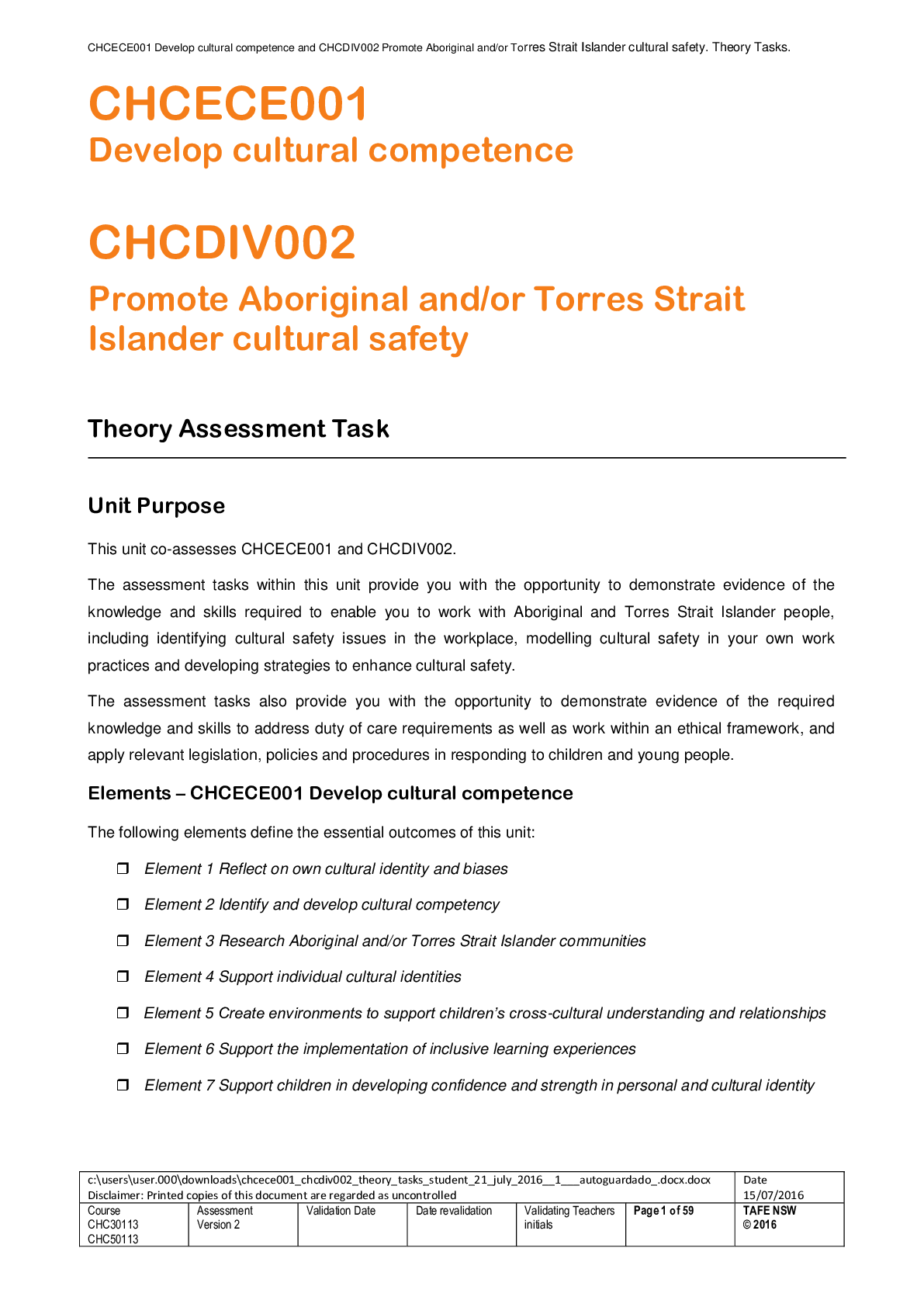
Reviews( 0 )
Recommended For You
Psychology> QUESTIONS & ANSWERS > CHCECE001 Develop cultural competence CHCDIV002 Promote Aboriginal and/or Torres Strait Islander cultural safety Theory Assessment Task (All)
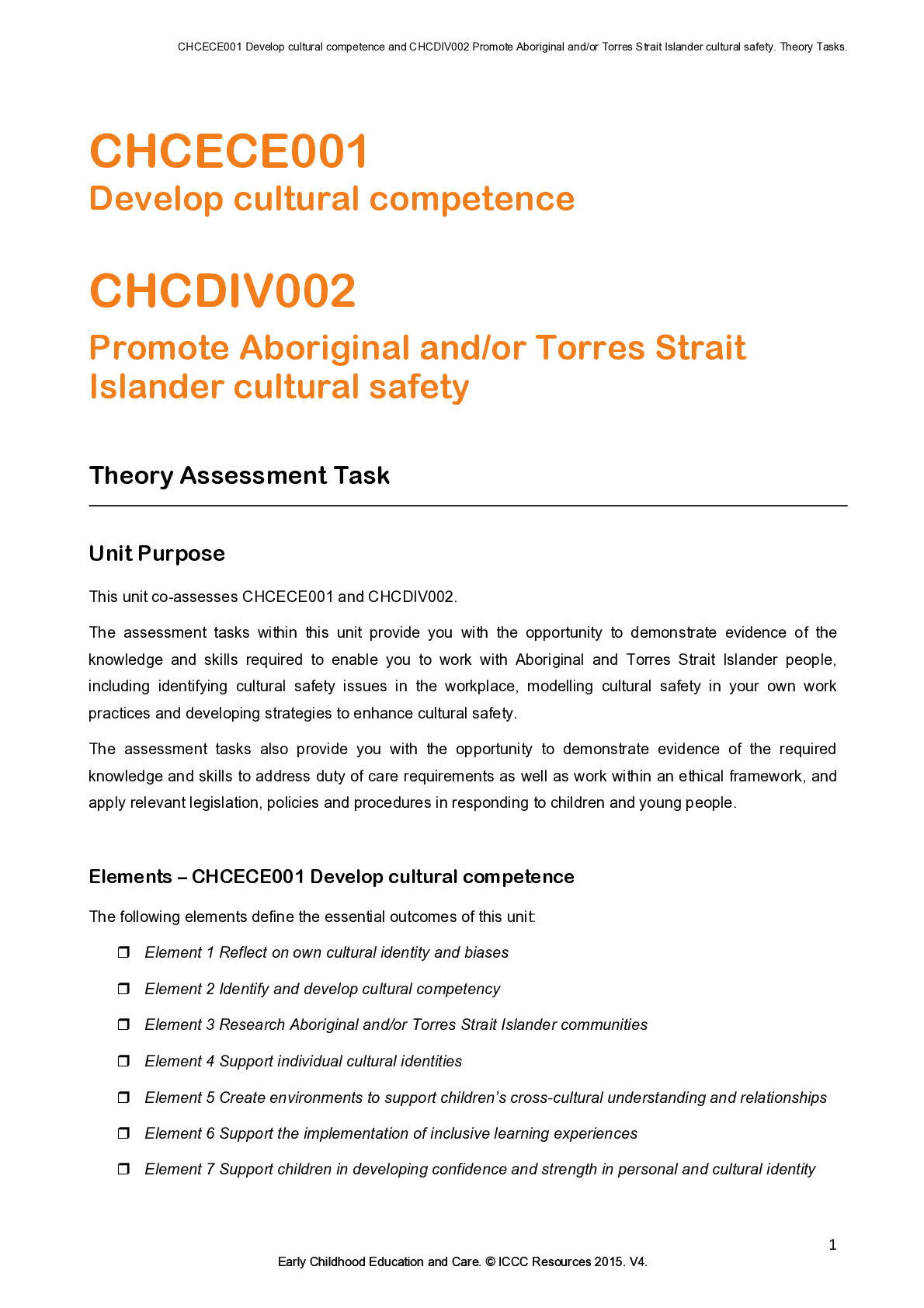
CHCECE001 Develop cultural competence CHCDIV002 Promote Aboriginal and/or Torres Strait Islander cultural safety Theory Assessment Task
CHCECE001 Develop cultural competence CHCDIV002 Promote Aboriginal and/or Torres Strait Islander cultural safety Theory Assessment Task CHCECE001 Develop cultural competence CHCDIV002 Pro...
By Kirsch , Uploaded: Jan 10, 2021
$9.5
Psychology> QUESTIONS & ANSWERS > Research Paper > 003 Aboriginal and/ or Torres Strait Islander Cultural Identity (All)
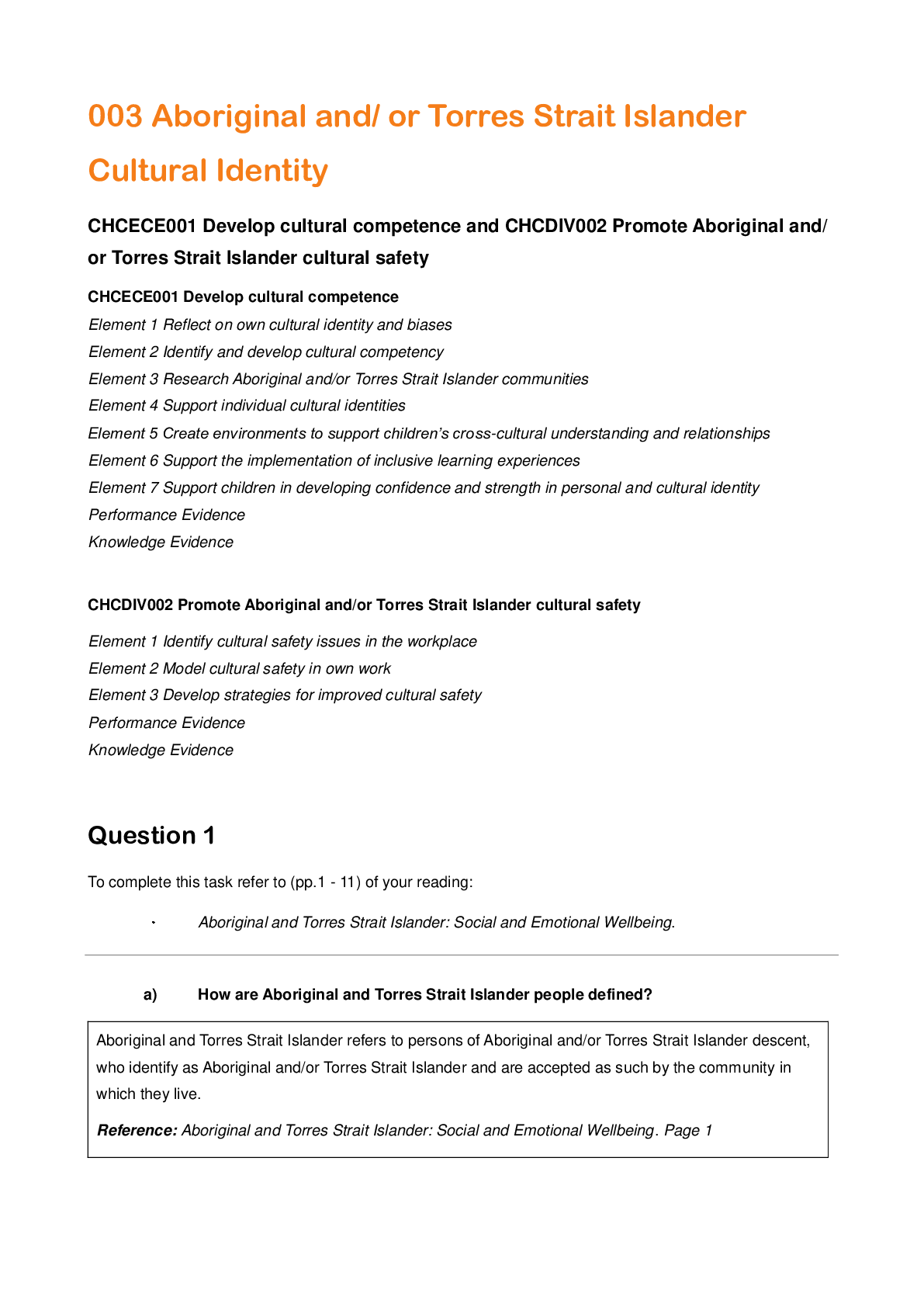
Research Paper > 003 Aboriginal and/ or Torres Strait Islander Cultural Identity
003 Aboriginal and/ or Torres Strait Islander Cultural Identity 003 Aboriginal and/ or Torres Strait Islander Cultural Identity CHCECE001 Develop cultural competence and CHCDIV002 Promote...
By Kirsch , Uploaded: Jan 10, 2021
$12
Sociology> QUESTIONS & ANSWERS > CHCECE001 CHCDIV002 DEVELOP CULTURAL COMPETENCE PROMOTE ABORIGINAL AND/OR TORRES STRAIT ISLANDER CULTURAL SAFETY. Knowledge Assessment Booklet. All Questions Answered Satisfactorily. (All)
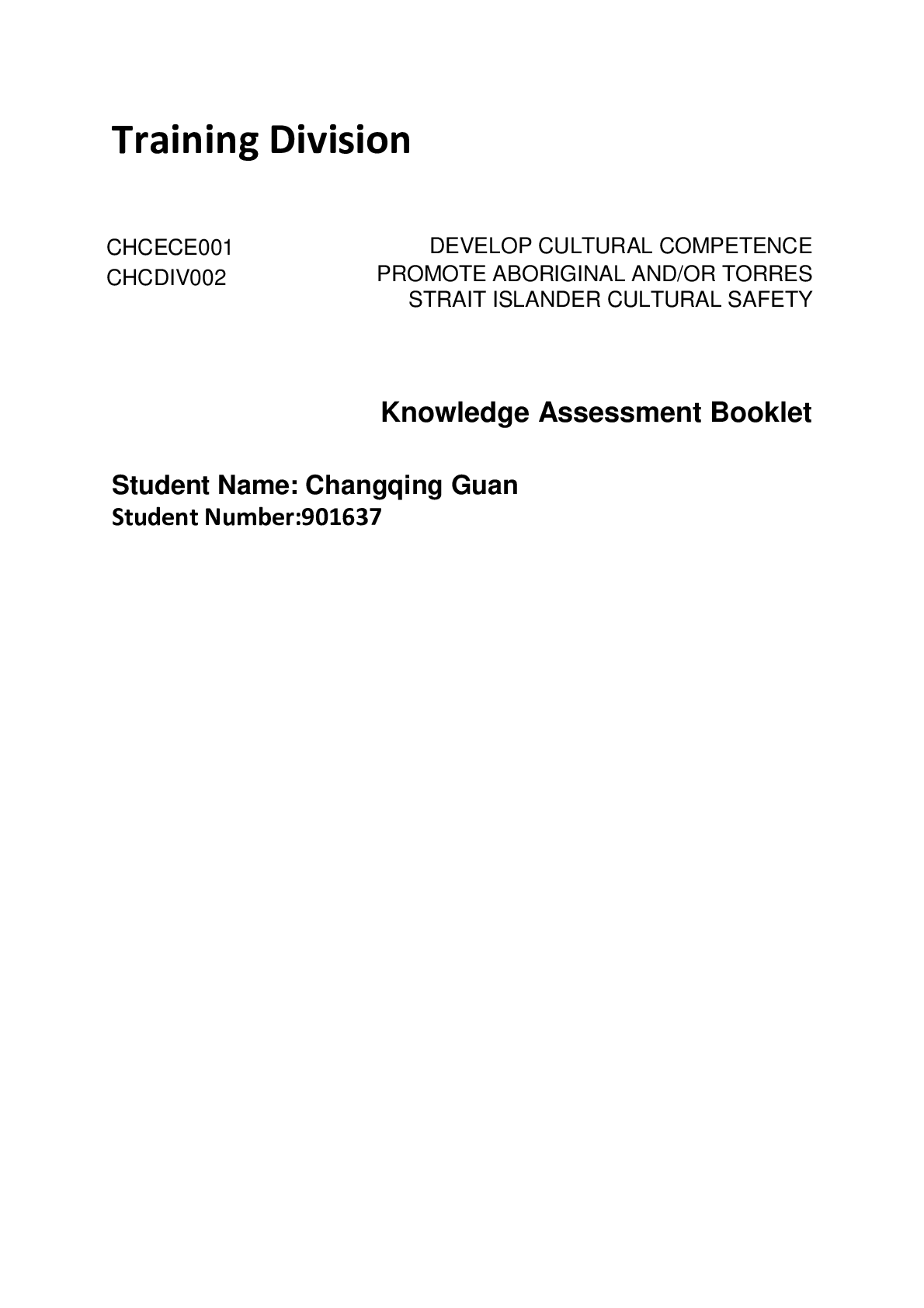
CHCECE001 CHCDIV002 DEVELOP CULTURAL COMPETENCE PROMOTE ABORIGINAL AND/OR TORRES STRAIT ISLANDER CULTURAL SAFETY. Knowledge Assessment Booklet. All Questions Answered Satisfactorily.
Training Division CHCECE001 CHCDIV002 DEVELOP CULTURAL COMPETENCE PROMOTE ABORIGINAL AND/OR TORRES STRAIT ISLANDER CULTURAL SAFETY Knowledge Assessment Booklet...
By Kirsch , Uploaded: Jan 10, 2021
$14
Business> QUESTIONS & ANSWERS > CLM 031 EXAM (All)
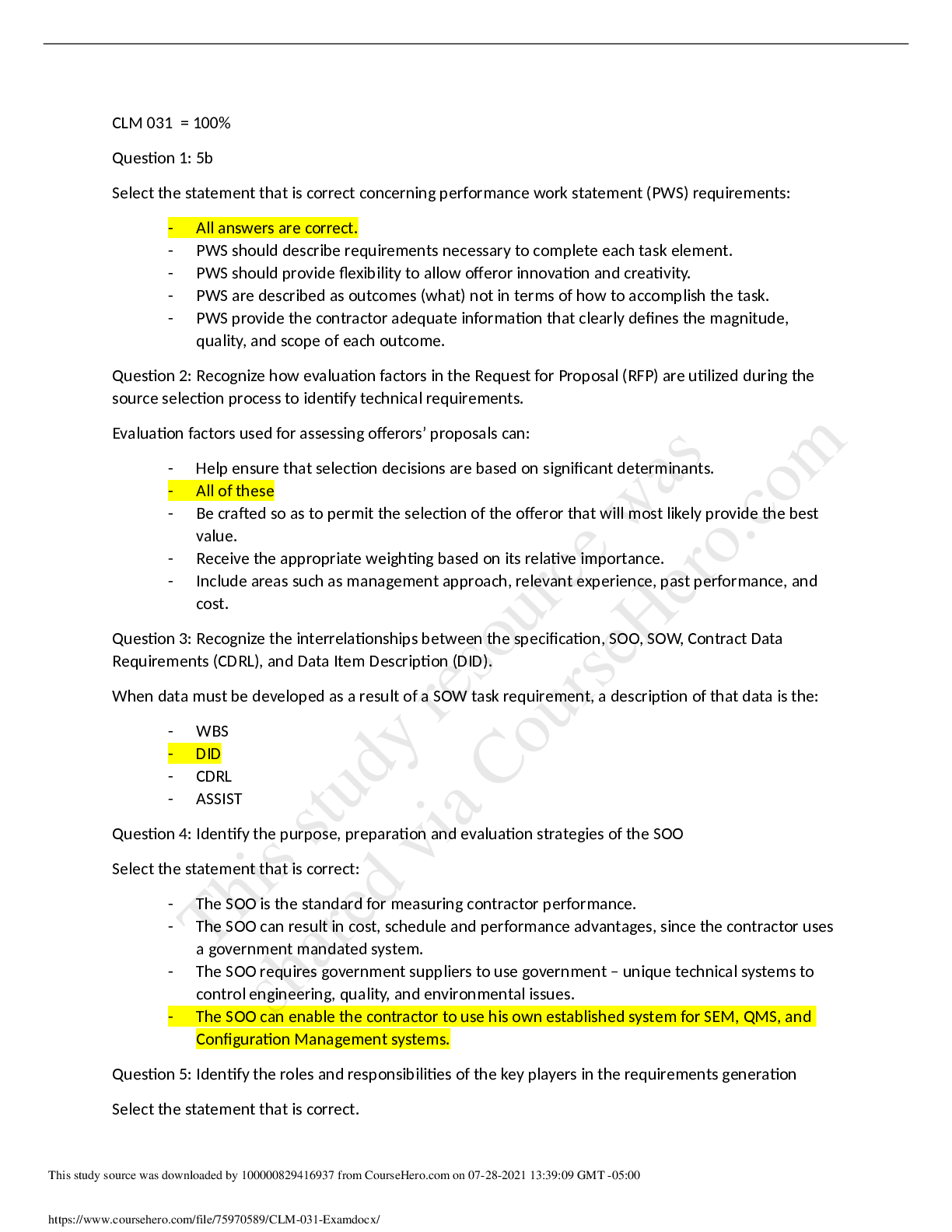
CLM 031 EXAM
CLM 031 = 100% Question 1: 5b Select the statement that is correct concerning performance work statement (PWS) requirements: - All answers are correct. - PWS should describe requirements necessary...
By Book Worm, Certified , Uploaded: Nov 03, 2022
$5
*NURSING> QUESTIONS & ANSWERS > PHIL 347 Week 6 Checkpoint Quiz. Score 100/100 (All)
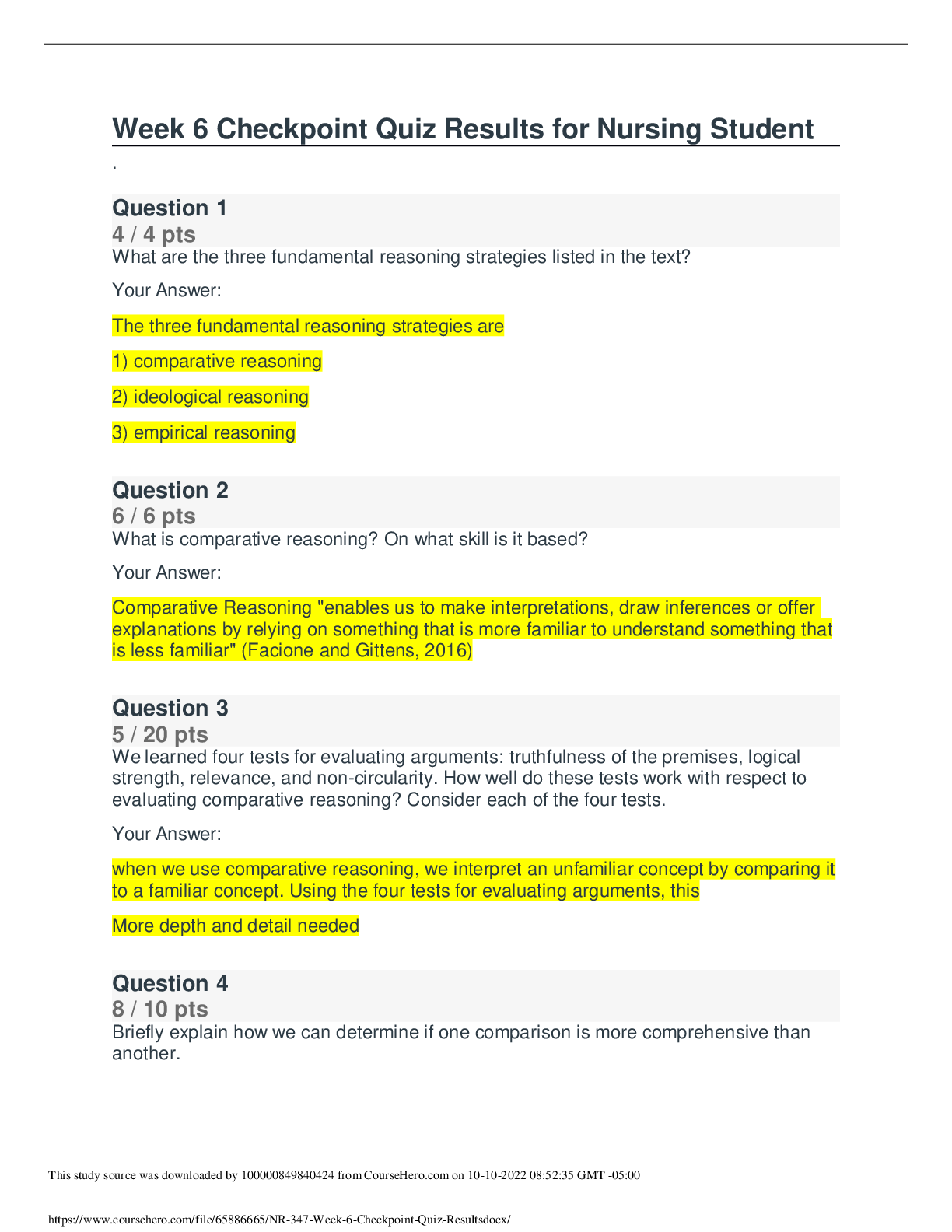
PHIL 347 Week 6 Checkpoint Quiz. Score 100/100
Question: What are the three fundamental reasoning strategies listed in the text? Question: What is comparative reasoning? On what skill is it based? Question: We learned four tests for evaluating...
By Amanda Rosales , Uploaded: Mar 24, 2021
$7
Business> QUESTIONS & ANSWERS > BUSINESS 1007 (All)

BUSINESS 1007
BUSINESS 1007 07 Key 1. (p. 178) Managers utilize organizational resources such as employees, information, and equipment to accomplish goals. 2. (p. 178) The main job of managers today is to w...
By Kirsch , Uploaded: Oct 19, 2019
$6
Anthropology> QUESTIONS & ANSWERS > KOR 352 FA19 101 week 8 Quiz. Already Graded A (All)

KOR 352 FA19 101 week 8 Quiz. Already Graded A
KOR 352 FA19 101: Week 8 Quiz Question 1 (0.25 points) Which of the following is not true of Kim and Finch’s observations during their field research in South Korea from 1997 to 2000? Question 1 o...
By Kirsch , Uploaded: Oct 17, 2019
$9
E-Commerce> QUESTIONS & ANSWERS > ESOC 316 Digital Commerce - University Of Arizona. Midterm Quiz. 20 Q&A. 100% Score (All)

ESOC 316 Digital Commerce - University Of Arizona. Midterm Quiz. 20 Q&A. 100% Score
ESOC 316 Digital Commerce - University Of Arizona. Midterm Quiz. 20 Q&A. 100% Score ESOC316 MIDTERM QUIZQuestion 6 (1 point) Saved Information has several properties that make information goods...
By Kirsch , Uploaded: Oct 15, 2019
$9.5
Marketing> QUESTIONS & ANSWERS > Marketing Management Chapter 2 to Chapter 10 Q&A (All)

Marketing Management Chapter 2 to Chapter 10 Q&A
Chapter 2 to Chapter 10 Chapter 2: Developing Marketing Strategies and Plans GENERAL CONCEPT QUESTIONS Multiple Choice 66 Chapter 1: Marketing: Managing Profitable Customer Relationships...
By Kirsch , Uploaded: Oct 14, 2019
$10
Marketing> QUESTIONS & ANSWERS > MKT 530 Customer Relationship Management. 155 Questions and Answers (All)

MKT 530 Customer Relationship Management. 155 Questions and Answers
MKT 530 All Questions and Answers MULTIPLE CHOICE. Choose the one alternative that best completes the statement or answers the question. 1) As the manager of an organization that is att...
By Kirsch , Uploaded: Oct 14, 2019
$10
Document information
Connected school, study & course
About the document
Uploaded On
Jan 10, 2021
Number of pages
59
Written in
Additional information
This document has been written for:
Uploaded
Jan 10, 2021
Downloads
0
Views
207






